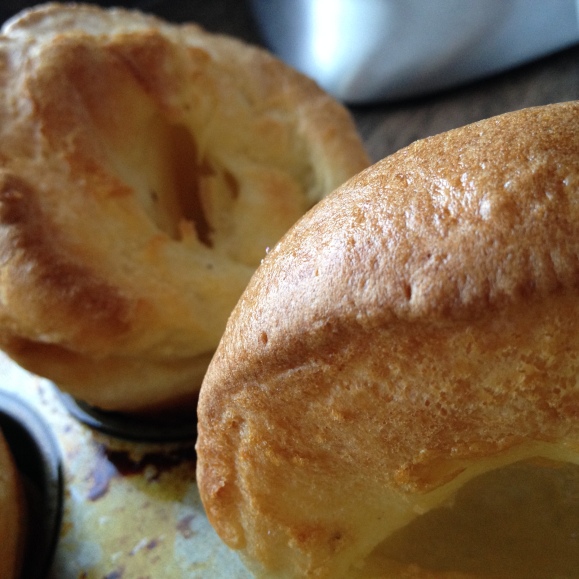
A Sunday supper of bright vegetables, tender roast beef, and savoury homemade gravy deserves a fresh Yorkshire pudding. And let’s get real: the Yorkshire pudding is going to be the part of the meal that you look forward to all week!
Yorkshire puddings are a Sunday night supper specialty in my house. We don’t make them too often, only now and then, but they are always a favourite at the dinner table (and to be sure, usually a couple are sneakily eaten even before dinner is plated and served at the table).
According to authors Glenn Rinsky and Laura Halpin Rinsky of The Pastry Chef’s Companion (2009), Yorkshire puddings are a sort of savoury popover named for the Yorkshire region of England, from which the dish originates. Author Alan Davidson tells readers that typically Yorkshire pudding is made of a thin batter in a single pan and often accompanies a roast beef supper (The Oxford Companion to Food, 1999). Davidson says that traditionally, as part of the Sunday supper, “the pudding, cut in squares, should be served with gravy before the meat, to take the edge off the appetite”. He does acknowledge however that as cooking practices shifted over time to reflect the advent of more modern kitchen ranges, appliances, and ovens, that Yorkshire puddings are often made in smaller, round tins instead of in one large pan as is traditional. He also notes that due to these technological shifts, enclosed oven ranges don’t allow for Yorkshire pudding to be cooked exactly as they traditionally were—baking in the steady heat of a roasting oven several inches below an exposed haunch of meat.
It is traditional to cook Yorkshire puddings using the juices and drippings from roast meat (and in particular those from roast beef), but nowadays people often use other cooking oils to start their puddings such as canola and vegetable oils. Important to achieving the lightness and crispness of a proper Yorkshire pudding is “introducing the [Yorkshire pudding] batter into a pan containing fat which is smoking hot, thus starting to form a crust underneath straight away; as the pudding continues to cook, the air incorporated into the batter during mixing expands, making it rise, and the fierce heat dies out the top of the pudding leaving it crunchy” (Davidson, 1999).

There’s that crispy exterior that’s all-important to a proper Yorkshire pudding! When the batter is poured into the heated pan and its sizzling hot oil, it immediately begins to cook. The oil helps to cook the thin batter thoroughly and provide the perfect crispy crust to the pudding.
My mother’s recipe is a bit of a hodge-podge, yet it remains simple and straight-forward enough to qualify as a decent Yorkshire pudding recipe. It was somewhat cobbled together from several (ever changing, and disappointingly unreliable) re-tellings of a ‘secret family recipe’ from my dad’s side of the family, and from a recipe that was published a number of years ago in the city newspaper following an interview with a chef from a popular local English/Irish pub. The recipe we use does not call for the drippings and juices from roast beef (as we usually use those to make the gravy), but nevertheless yields a delicious Yorkshire pudding that has a perfect balance of airiness and crispiness. In fact, due to this airy crispiness, these puddings tower in the pan, as proper Yorkshire puddings should. Should there be any left over after supper (not as frequent a situation as you might think), they serve well the next day paired with reheated leftovers, savoury spreads like spicy mustards, or sweet homemade jams.
The one bit of caution that I would advise anyone of when making Yorkshire puddings (besides the ever present warning of: careful, the oil will be very hot!) is to designate a separate baking tin as the tin that will forevermore be specifically used for Yorkshire puddings. The hot oil needed for cooking the puddings can discolour a baking tin to the point of being nearly unrecognizable after the first few times of making Yorkshire puddings.
But it’s a small price to pay—an ugly, discoloured tin—for the deliciousness of fresh Yorkshire puddings during a Sunday supper.

Trust me, there’s some kind of unwritten rule that the best Yorkshire puddings come from the gnarliest looking pans! (Seriously though, you may want to designate and set aside a pan specifically for making Yorkshire puddings and Yorkshire puddings alone–discolouration that will happen to that thing.)